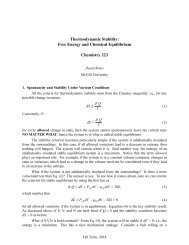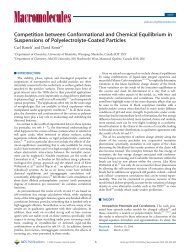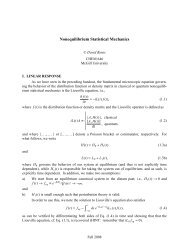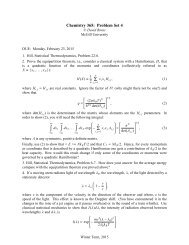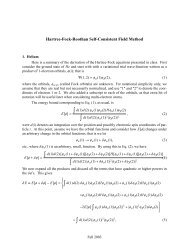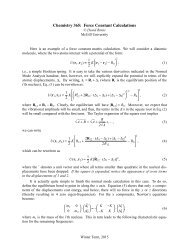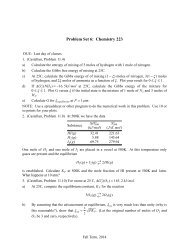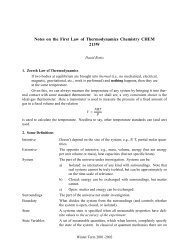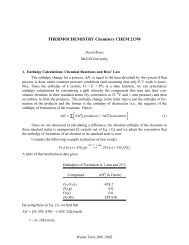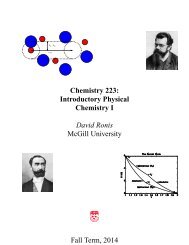Benoit Palmieri and David Ronis, Diffusion in ... - McGill University
Benoit Palmieri and David Ronis, Diffusion in ... - McGill University
Benoit Palmieri and David Ronis, Diffusion in ... - McGill University
Create successful ePaper yourself
Turn your PDF publications into a flip-book with our unique Google optimized e-Paper software.
<strong>Diffusion</strong> <strong>in</strong> Channeled Structures J. Phys. Chem. B, Vol. 109, No. 45, 2005 21341<br />
∞<br />
Figure 10. Factor ∫0 dt 〈Vz(t1)Vz〉r e-[W(r)-W(z)] <strong>in</strong> the maximum W(z)<br />
plane where an area of 2.757 × 3.46 Å is shown.<br />
an upper bound to Smoluchowski processes (cf. ref 28). The<br />
difference cannot be expla<strong>in</strong>ed from the cooperative motion of<br />
the guest <strong>and</strong> the lattice atoms s<strong>in</strong>ce, as shown <strong>in</strong> Figure 7, the<br />
vibrations tend to reduce the diffusion. One possible explanation<br />
of the discrepancy between TST <strong>and</strong> our calculation is the<br />
follow<strong>in</strong>g. First recall that D0 is obta<strong>in</strong>ed from the plane average<br />
∞<br />
of ∫0 dt 〈Vz(t1)Vz〉r e-[W(r)-W(z)] . This factor is shown <strong>in</strong> Figure<br />
10 for the W(z) maximum energy plane (which is very close to<br />
the plane that conta<strong>in</strong>s the saddle po<strong>in</strong>t). In the context of TST,<br />
this factor is assumed to be harmonic with the maximum at the<br />
saddle po<strong>in</strong>t. It is clear from the figure that the harmonic<br />
approximation is not accurate. In conclusion, TST seems to more<br />
effectively describe the averaged diffusion process <strong>in</strong> our large<br />
energy barriers system (18kBT at 300 K) than it did <strong>in</strong> I for<br />
smaller energy barriers (2kBT at 300 K), although the assumption<br />
about what regions of phase space contribute to the diffusion<br />
process is still wrong.<br />
Most experiments (cf. refs 18 <strong>and</strong> 21) claim that the preexponential<br />
factor, D′, as def<strong>in</strong>ed <strong>in</strong> eq 5.7, does not appreciably<br />
change with temperature. The prefactor is directly proportional<br />
to D0 <strong>and</strong> the nonideal corrections appear<strong>in</strong>g <strong>in</strong> eq 5.4. By<br />
assum<strong>in</strong>g the gas is ideal <strong>in</strong> the bulk <strong>and</strong> that the saddle-po<strong>in</strong>t<br />
curvatures are <strong>in</strong>dependent of temperature, TST predicts that<br />
D0 ∝ T3/2 , compare to eq 4.2. This is not supported by the data,<br />
compare to Table 1, s<strong>in</strong>ce there is significant temperature<br />
dependence <strong>in</strong> the curvatures. Indeed, the TST results are welldescribed<br />
by a T1.28 power law, while our method predicts T1.1 ,<br />
albeit with larger deviations. In both models, the temperature<br />
dependence is clear, but this effect is very hard to see <strong>in</strong> an<br />
Arrhenius plot (cf. Figure 5) <strong>and</strong> would be even harder to see<br />
<strong>in</strong> a real experiment given the large error bars reported for D′.<br />
In conclusion, we have shown that the driv<strong>in</strong>g forces for the<br />
diffusion of a guest <strong>in</strong> a large energy barrier system are different<br />
than <strong>in</strong> I where we considered a small energy barrier system.<br />
The permeability is very sensitive to the accuracy of the<br />
activation energy, <strong>and</strong> that of the underly<strong>in</strong>g potential model,<br />
<strong>and</strong> to the flexibility of the lattice. For a more accurate<br />
evaluation of the permeabilities, a potential model that describes<br />
the repulsive <strong>in</strong>teractions better, result<strong>in</strong>g <strong>in</strong> a more negative<br />
activation entropy, would be required. The goal of this work<br />
was to establish what phenomena contribute to the prefactor,<br />
<strong>and</strong> we have shown that the prefactor depends on the cooperative<br />
motion between the guest <strong>and</strong> the lattice. This effect is absent<br />
<strong>in</strong> TST <strong>and</strong> all frozen lattice or adiabatically equilibrated lattice<br />
simulations <strong>and</strong> can lead to non-negligible errors <strong>in</strong> systems<br />
with large energy barriers <strong>and</strong> concomitantly large forces.<br />
Acknowledgment. First <strong>and</strong> foremost, we thank the organizers<br />
of this Festschrift honor<strong>in</strong>g Irw<strong>in</strong> Oppenheim for <strong>in</strong>vit<strong>in</strong>g<br />
us to take part. Irw<strong>in</strong> has been a mentor <strong>and</strong> friend for many<br />
years, is <strong>in</strong>terested <strong>in</strong> all aspects of science, <strong>and</strong> has played an<br />
important role <strong>in</strong> help<strong>in</strong>g many young scientists get started. That<br />
he has done all this while, at the same time, rema<strong>in</strong><strong>in</strong>g a decent<br />
<strong>and</strong> gentle man is someth<strong>in</strong>g we should all strive to emulate.<br />
We thank the <strong>McGill</strong>’s Center for the Physics of Materials for<br />
the use of the Beowulf cluster <strong>and</strong>, <strong>in</strong> particular, Dr. Juan<br />
Gallego for help<strong>in</strong>g us with several parallel process<strong>in</strong>g issues.<br />
We also thank the Natural Sciences <strong>and</strong> Eng<strong>in</strong>eer<strong>in</strong>g Research<br />
Council of Canada for support<strong>in</strong>g this work. F<strong>in</strong>ally, one of us<br />
(B.P.) thanks the Fonds de recherche sur la nature et les<br />
technologies for support.<br />
References <strong>and</strong> Notes<br />
(1) <strong>Palmieri</strong>, B.; <strong>Ronis</strong>, D. Phys. ReV. E: Stat. Phys., Plasmas, Fluids,<br />
Relat. Interdiscip. Top. 2003, 68, 046127.<br />
(2) Vertenste<strong>in</strong>, M.; <strong>Ronis</strong>, D. J. Chem. Phys. 1986, 85, 1628.<br />
(3) <strong>Ronis</strong>, D.; Bedeaux, B.; Oppenheim, I. Physica A 1978, 90, 487.<br />
(4) Mehra, V.; Basra, R.; Khanna, M.; Chakravarty, C. J. Phys. Chem.<br />
B 1999, 103, 2740.<br />
(5) Mossell, T.; Schrimpf, G.; Brickmann, J. J. Phys. Chem. B 1997,<br />
101, 9476.<br />
(6) Mossell, T.; Schrimpf, G.; Brickmann, J. J. Phys. Chem. 1996, 100,<br />
4582.<br />
(7) Demontis, P.; Stara, G.; Suffritti, G. B. J. Chem. Phys. 2004, 120,<br />
9233.<br />
(8) Kopelevich, D. I.; Chang, H.-C. J. Chem. Phys. 2001, 114, 3776.<br />
(9) Demontis, P.; Suffritti, G. B.; Fois, E. S.; Quartieri, S. J. Phys.<br />
Chem. 1992, 96, 1482.<br />
(10) Suffritti, G. B.; Demontis, P.; Ciccotti, G. J. Chem. Phys. 2003,<br />
118, 3439.<br />
(11) Demontis, P.; Suffritti, G.; Bordiga, S.; Buzzoni, R. J. Chem. Soc.,<br />
Faraday Trans. 1995, 91, 525.<br />
(12) Vertenste<strong>in</strong>, M.; <strong>Ronis</strong>, D. J. Chem. Phys. 1987, 87, 5457.<br />
(13) Deutch, J. M.; Silbey, R. Phys. ReV. A: At., Mol., Opt. Phys. 1971,<br />
3, 2049.<br />
(14) Rickwardt, C.; Nielaba, P.; Müser, M. H.; B<strong>in</strong>der, K. Phys. ReV.<br />
B: Solid State 2001, 63, 045204.<br />
(15) Schober, H.; Strauch, D.; Nützel, K.; Dorner, B. J. Phys.: Condens.<br />
Matter 1993, 5, 6155.<br />
(16) Striefler, M. E.; Barsch, R. Phys. ReV. B: Solid State 1975, 12,<br />
4553.<br />
(17) Kloeden, P. E.; Platen, E. Numerical Solutions of Stochastic<br />
Differential Equations; Spr<strong>in</strong>ger-Verlag: Berl<strong>in</strong>, 1994.<br />
(18) Watson, E. B.; Cherniak, D. J. Geochim. Cosmochim. Acta 2003,<br />
67, 2043.<br />
(19) Chu, W.-K.; Mayer, J. W.; Nicolet, M.-A. Backscatter<strong>in</strong>g Spectrometry;<br />
Academic Press: New York, 1978.<br />
(20) Hansen, J. P.; McDonald, I. R. Theory of simple liquids; Academic<br />
Press: London, 1976.<br />
(21) Carroll, M. R.; Stolper, E. M. Geochim. Cosmochim. Acta 1991,<br />
55, 211.<br />
(22) Cherniak, D. J. Earth Planet. Sci. Lett. 2003, 214, 655.<br />
(23) Béj<strong>in</strong>a, F.; Jaoul, O. Phys. Earth Planet. Inter. 1996, 97, 145.<br />
(24) London, F. Z. Phys. Chem. B 1930, 11, 222.<br />
(25) Kirkwood, J. G. Phys. Z. 1932, 33, 57.<br />
(26) Muller, H. R. Proc. R. Soc. London, Ser. A 1936, 154, 624.<br />
(27) Barrer, R. M.; Peterson, D. L. Proc. R. Soc. London, Ser. A. 1964,<br />
280, 466.<br />
(28) Ch<strong>and</strong>rasekhar, S. ReV. Mod. Phys. 1943, 15, 1.




